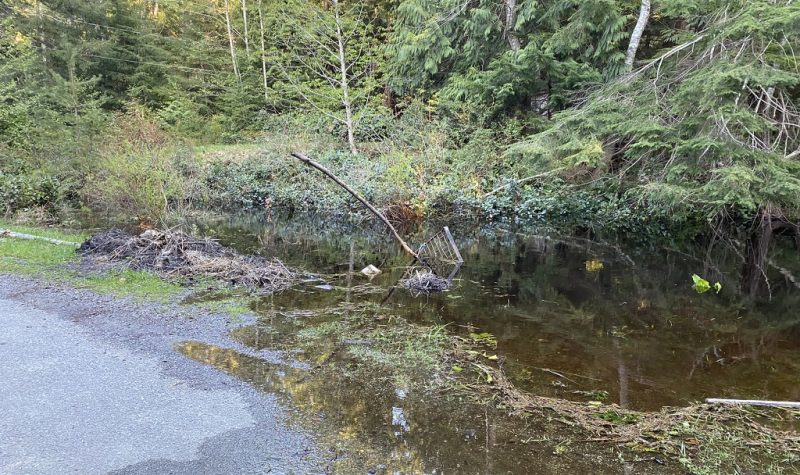A local environmental group believes that the road runoff from seasonal weather is contributing to harmful algae in lakes on Cortes Island.
Winter storm surges concentrate phosphorus in local lakes, the main element causing summer algae build up, or algal blooms, in Hague and Gunflint, suggests Friends of Cortes Island (FOCI), the environmental non-profit. Roads and ditch systems "are like highways for water" that carry minerals from agricultural activities and flush them into the lakes.
Algal blooms result in a lack of oxygen in the lake and can cause wildlife mortality, according to FOCI. The algal blooms can also cause unpleasant smells, taste, and an itch to the skin. Through eight years of research, FOCI has determined that some of the main contributing factors to the local blooms are archaic residential septic systems; drained or dwindling wetlands on agricultural land; and the roads and ditch systems surrounding the lakes.
Miranda Cross, a local wetland restoration expert and member of FOCI, says phosphorus has been accumulating in the local watersheds of Hague and Gunflint Lakes at alarming levels. High nutrient levels of phosphorus are feeding the lakes via the public ditch systems, and have been causing algal blooms since at least 2014.
Cross agreed that the algal blooms are associated with road-building techniques and infrastructure.
"Phosphorus binds to soils. This is where it becomes important thinking about ditching and channeling of streams. That's when we get erosion, whether it's in ditches or streams the soil gets carried and the soil is what has the phosphorus in it... Phosphorus is also found in manures and a lot of garden amendments, so that could also be a source if there's, runoff from manure going into the lakes. There's lots of homes and gardens and farms all around both lakes, right? If we get runoff that's entering ditches... you can think of ditches as highways for water where water's moving unimpeded really quickly in a channelized area," Cross said.
Rex Weyler is a co-founder of Greenpeace and an active member of FOCI. He responded to CKTZ via email, explaining how roads and ditch systems play a key factor in the algal blooms.
“The water from road drainage…is channeled along the side of the road, then ditched down to the lakes, so that the water enters the lakes with a full load of nutrients, which feeds the algae blooms,” he said.
FOCI has partnered with local farms, Strathcona Regional District, and BC Wildlife Federation to improve the ecological chemistry of the lakes. The environmental non-profit initiated an awareness campaign called Love the Lakes to highlight the main causes of algal blooms on the highly-frequented and locally beloved waterbodies.
The Cortes Housing Society and the Cortes Community Economic Development have also integrated wetland restoration design into community land developments in the Hague Lake Watershed and have recently applied for Natural Infrastructure Grants to fund the creation of bioswales and holding ponds.
One of the main, unaddressed issues that is still contributing to algal blooms is the public roads and ditch systems, surrounding the lakes, according to FOCI.
"We'd be interested in cooperating with MOTI to address the effects of road drainage," said Lisa Ferentinos, FOCI representative.
CKTZ reached out to Ministry of Transportation and Infrastructure (MOTI) to find out if they are aware of the community concern and exploring solutions.
"The ministry is increasingly looking at things like bioswales and storm water ponds during project design, particularly when the project is close to a sensitive water body."
CKTZ inquired about annual budgets for road maintenance allocated to Cortes Island, the ministry responded, "The Ministry of Transportation Infrastructure doesn't have an annual budget specific to road improvements on Cortes Island."
MOTI echoes the local environmentalist's list of possible solutions like bioswales and holding ponds, but capacity is limited by funding.
"All rehabilitation projects for provincial roads across the province are funded, in order of priority, through the Ministry’s Transportation and Infrastructure Improvements budget," MOTI told CKTZ News.
MOTI encourages concerned locals to reach out to the local office in Nanaimo, call the office at 250.751.3246.
To learn more about the local algal blooms listen to the CKTZ News Update below:


